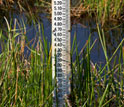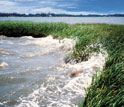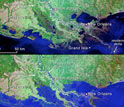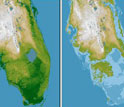News Release 12-051
Global Sea Level Likely to Rise as Much as 70 Feet in Future Generations
Scientists looked back in time--in the geologic record--to see the future
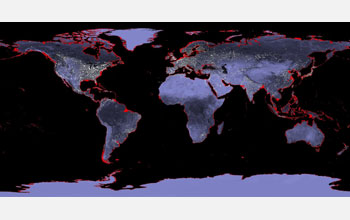
Earth with a sea level rise of six meters. Imagine a possible future rise of 70 feet.
March 19, 2012
This material is available primarily for archival purposes. Telephone numbers or other contact information may be out of date; please see current contact information at media contacts.
Even if humankind manages to limit global warming to 2 degrees Celsius (3.6 degrees Fahrenheit)--as the Intergovernmental Panel on Climate Change recommends--future generations will likely have to deal with a completely different world.
One with sea levels 40 to 70 feet higher than at present, according to research results published this week in the journal Geology.
The scientists, led by Kenneth Miller of Rutgers University, reached their conclusion by studying rock and soil cores taken in Virginia, New Zealand and the Eniwetok Atoll in the north Pacific Ocean.
They looked at the late Pliocene epoch, 2.7 million to 3.2 million years ago, the last time the carbon dioxide level in Earth's atmosphere was at its current level and when atmospheric temperatures were 2 C higher than they are now.
"The difference in water volume released is the equivalent of melting the entire Greenland and West Antarctic Ice Sheets, as well as some of the marine margin of the East Antarctic Ice Sheet," said H. Richard Lane, program director in the National Science Foundation's Division of Earth Sciences, which funded the work.
"Such a rise of the modern oceans would swamp the world's coasts and affect as much as 70 percent of the world's population."
"You don't need to sell your beach real estate yet, because melting of these large ice sheets will take centuries to millennia," Miller said.
"The current trajectory for the 21st century global rise of sea level is 2 to 3 feet due to warming of the oceans, partial melting of mountain glaciers and partial melting of Greenland and Antarctica."
Miller said, however, that the results highlight the sensitivity of Earth's great ice sheets to temperature change, suggesting that even a modest rise in temperature would result in a large sea-level rise.
"The natural state of the Earth with present carbon dioxide levels is one with sea levels about 70 feet higher than now," he said.
Imagine what the future may well look like on a very blue planet.
Rutgers colleagues James Wright, James Browning, Yair Rosenthal, Sindia Sosdian and Andrew Kulpecz join Miller in the research.
Other co-authors are Michelle Kominz of Western Michigan University; Tim Naish of Victoria University of Wellington in New Zealand; Benjamin Cramer of Theiss Research in Eugene, Oregon; and W. Richard Peltier of the University of Toronto.
-NSF-
-
How far will future sea level rise? New projections say 70 feet and counting.
Credit and Larger Version -
Wetlands along U.S. coastlines and around the world are at risk from sea level rise.
Credit and Larger Version -
As sea level rises, the coast of Louisiana begins to go underwater.
Credit and Larger Version -
Florida flooded: what the state may look like in decades to come.
Credit and Larger Version -
Virginia Beach and other cities and towns built largely on barrier islands may be swamped.
Credit and Larger Version
Media Contacts
Cheryl Dybas, NSF, (703) 292-7734, email: cdybas@nsf.gov
The U.S. National Science Foundation propels the nation forward by advancing fundamental research in all fields of science and engineering. NSF supports research and people by providing facilities, instruments and funding to support their ingenuity and sustain the U.S. as a global leader in research and innovation. With a fiscal year 2023 budget of $9.5 billion, NSF funds reach all 50 states through grants to nearly 2,000 colleges, universities and institutions. Each year, NSF receives more than 40,000 competitive proposals and makes about 11,000 new awards. Those awards include support for cooperative research with industry, Arctic and Antarctic research and operations, and U.S. participation in international scientific efforts.
Connect with us online
NSF website: nsf.gov
NSF News: nsf.gov/news
For News Media: nsf.gov/news/newsroom
Statistics: nsf.gov/statistics/
Awards database: nsf.gov/awardsearch/
Follow us on social
Twitter: twitter.com/NSF
Facebook: facebook.com/US.NSF
Instagram: instagram.com/nsfgov



